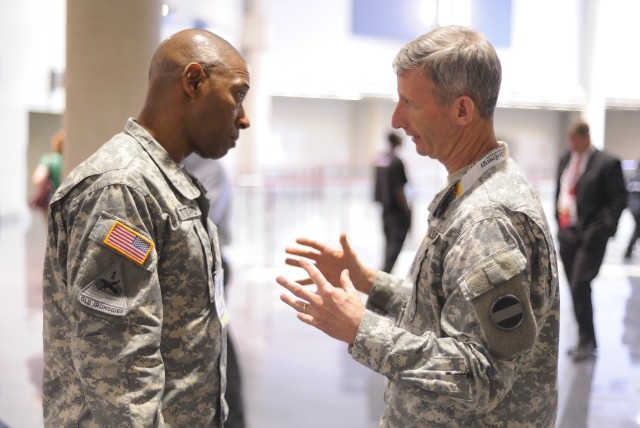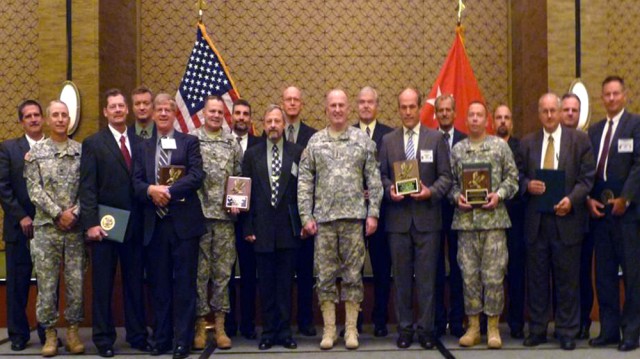DALLAS (Army News Service, Aug. 27, 2010) - This year's GovEnergy workshop and tradeshow at the Dallas Convention Center, Aug. 15-18, hosted nearly 4,000 attendees and more than 300 speakers from the private and public sector including Army energy managers and senior leadership all working o reduce carbon emissions and make use of renewable and alternative energy sources.
Senior Army officials and energy managers discussed Army-specific issues ranging from acquiring funding for renewable, alternative energy security and energy conservation and efficiency projects to outfitting Soldiers on the frontlines with more efficient energy sources.
Maj. Gen. Howard B. Bromberg, special assistant to the U.S. Army Forces Command commanding general at Fort McPherson, Ga., spoke and participated in a panel on energy security during the conference.
Bromberg, who relinquished command of Fort Bliss, Texas, to Maj. Gen. Dana J. H. Pittard in July, addressed a room of energy managers, engineers, government officials, equipment manufacturers and others on day one about the FORSCOM perspective of energy management, drawing partly from his experience at Fort Bliss.
"Is this a limiting factor for us, or should it be a capability'" Bromberg asked the group about energy. "My view is that in the future, we need to take this limiting factor and turn it into a capability."
Enemies have always feared the U.S. military's lethality, Bromberg told attendees, whether that lethality is from an individual Soldier with an M-4 or from a joint strike fighter.
"In the future, it would be nice if our enemies of the world would fear our energy capability, just like they fear our lethality today," Bromberg said. "Just think about that for a minute, and maybe that's a stretch, but if you were known as the person who had unlimited resources, could move uninhibited throughout the world and never feared for the need of any energy, that would change the whole fight."
Also participating in the energy security panels was Toufic Alhaj, chief of the business operations and integration division at Fort Bliss' directorate of public works.
Alhaj, whose guidance under Bromberg had been to make Fort Bliss the Army's Center for Renewable Energy by 2015, and "net zero" by 2025 by enabling the post to create more energy than it uses, is now operating with a new deadline of Dec. 31, 2015 based on Pittard's vision.
The week before the conference, Pittard announced the new timeline during a media roundtable at Fort Bliss, stressing the importance of community partnerships.
"We are moving out with renewable energy here at Fort Bliss," Pittard told reporters during the Aug. 13 question-and-answer session. "We dearly want to partner with El Paso as we do that, in many ways.
"My hometown is called the Sun City," the El Paso native added, "and we're hoping that that will mean something in the area of solar energy someday for El Paso's place in our nation."
"We have to solicit partnerships, because we can't do this alone," Alhaj agreed during the conference, and added that the post now needs to move faster and look for more funding.
With Alhaj leading the energy effort at the 1.2 million acre post, Fort Bliss is looking to exploit at least six renewable energy sources to meet the target: geothermal, solar thermal, solar photovoltaic, solar day-lighting, wind and biomass.
Geothermal and solar power are each a short-range focus, while the former is still being studied with the latter being referred to as "hanging fruit" by Alhaj. If geothermal turns out to be a viable power source, he said it may give Fort Bliss almost 50 percent of its power requirement. Alhaj said he should know how viable it is within nine months.
In the realm of solar power, Alhaj said the installation has already met federal energy mandates, including generating three percent of its energy demands through solar power. An executive order also mandates 7.5 percent renewable energy by 2013, while the Defense Department requires a two percent reduction of consumption per year.
Merely meeting the mandated goals, however, is not what the commander is looking for.
Instead, exceeding those standards is Pittard's goal. The ability of Fort Bliss to produce its own power from clean energy sources in order to reach energy independence, reduce greenhouse emissions and provide power not only inside the fence but outside to neighboring communities, for example, are some of Pittard's goals.
"This is how passionate he is about it," Alhaj said of the commander after the two spoke at length during the conference. "I learned he is not going to take no for an answer.
"It's a very aggressive goal - expensive, but doable," Alhaj added. "He noticed that we're doing so well with efficiency and conservation, so we have met all the renewable energy mandates. He wants to go beyond that."
Alhaj said the process of change is also a cultural one, not only technological.
"If I put all these sensors in the room here, and a person comes and turns on the light and ignores what I did, it's worthless," said Alhaj.
"When we started the [solar] panels, everybody said, 'What is that''" he said. "While we were finishing it, I noticed Soldiers first would come out and hide from the hot weather under them. Now they go park there, and now some of them drive electric vehicles. They go and plug them in.
"The seed is there," he added. "I think where there is a will, there is a way."
If Fort Bliss taps into any of the renewable energy resources, Alhaj said he predicts the post will still "hit 10 birds with one stone," by meeting all of the Army's Strategic Energy Security Goals as defined by the office of the assistant secretary of the Army for installations and environment - which include surety, supply, sustainability, sufficiency and survivability - as outlined in the Army Energy Security Implementation Strategy.
According to the AESIS guidance, this means "preventing loss of access to power and fuel sources (surety), ensuring resilience in energy systems (survivability), accessing alternative and renewable energy sources available on installations (supply), providing adequate power for critical missions (sufficiency), and promoting support for the Army's mission, its community and the environment (sustainability)."
The office of the assistant secretary of the Army for installations and environment has also defined five related energy goals, including reducing energy consumption, increasing "energy efficiency across platforms and facilities," and reducing "adverse impacts on the environment," in their guidance.
The goals are designed to be implemented while not reducing the Army's capability to operate normally or carry out its missions, according to the AESIS.
"I think these goals are reasonable goals," he said, "but funding is always an issue."
So far, Alhaj has managed the Fort Bliss effort to meet and exceed such AESIS goals with projects that include installing solar photovoltaic panels across post, about 1,000 solar day-lights to replace conventional lamps, building "envelop" retrofits that are expected to save at least half a million dollars, advanced metering, and solar thermal heating at the post's Replica Aquatic Center.
In addition to finding funding and dealing with a compressed timeline, standing in the way of Fort Bliss' energy goals are mandatory environmental impact studies, approvals, and the legal protocol involved in networking with potential private-sector industry partners. The conference, however, cut some of that networking red tape in half, Alhaj said.
"This constraint goes away because now I can go into their booth as a visitor," he said. "Some of them wanted to come visit me, but I had to go through the protocol. I don't have to do that [here]. I can walk in and talk. They gave me all this stuff they have to offer, and that's a big accomplishment by itself."
Whether the change saves money, increases the Army's warfighting capabilities, improves the security of the Army's infrastructure, reduces the military's "carbon bootprint," conserves energy, or all of the above, Alhaj said the energy problem applies to everyone.
"Energy is everybody's business, whether you're a child, a civilian, a Soldier, a teacher," he said. "We have to change. Saving energy is saving lives, and dollars."
(Stephen Baack serves with Fort Bliss Public Affairs.)






Social Sharing